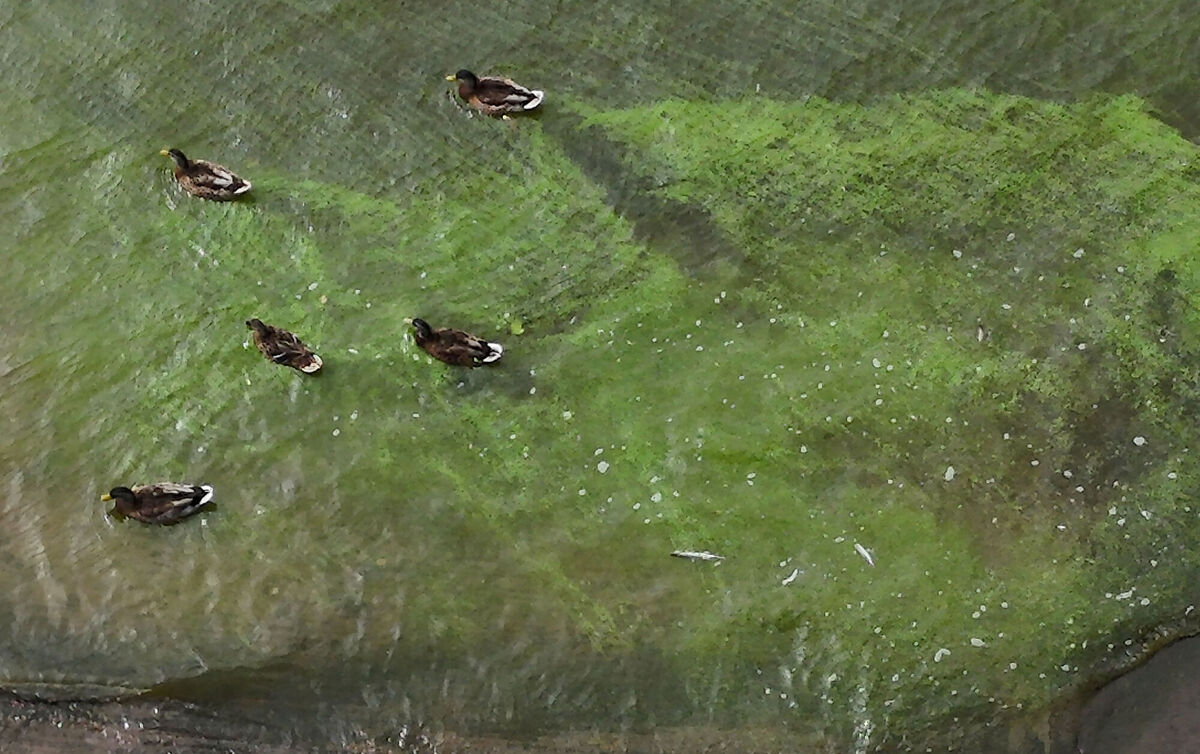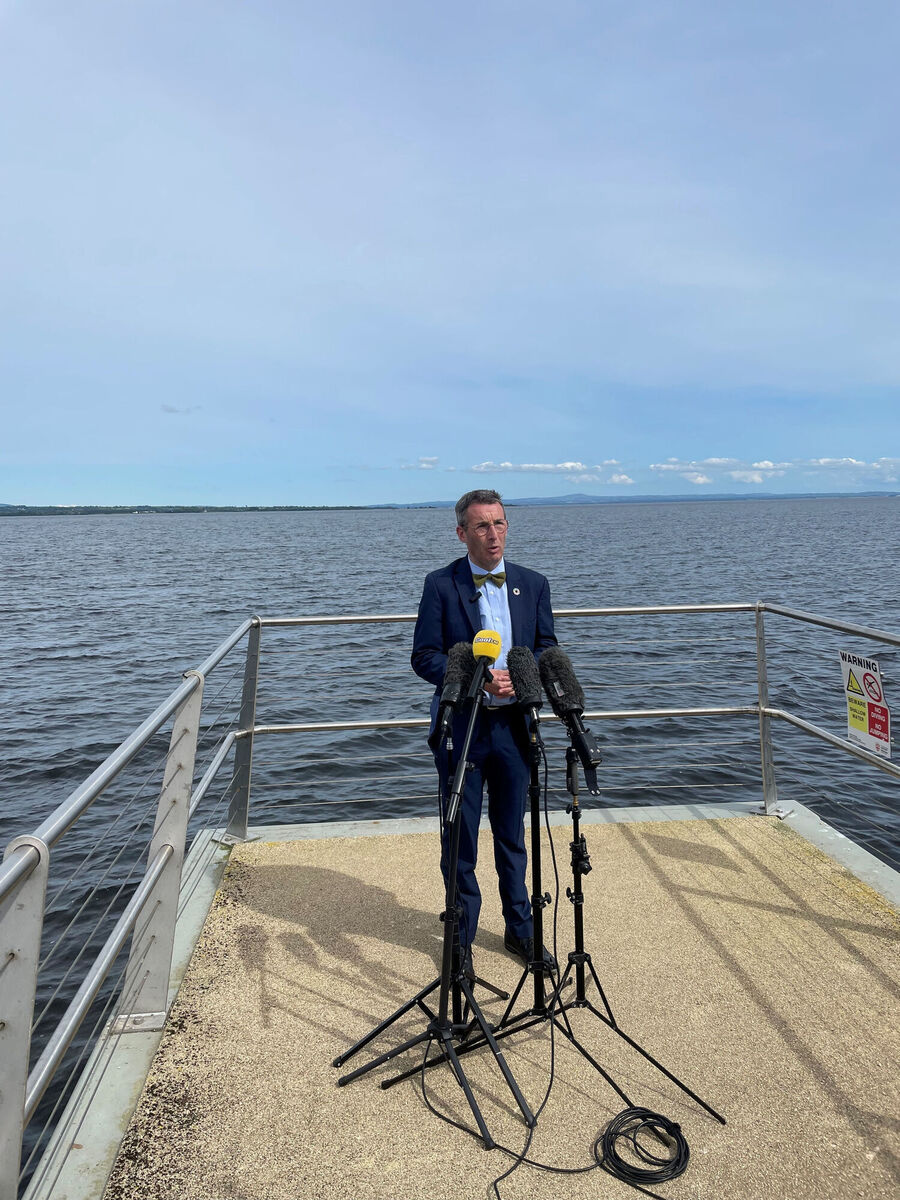Anja Murray: Urgent action needed to make Lough Neagh pollution and green sludge a distant memory

Blue Green Algae concentrations on the shores of Lough Neagh in County Antrim. Picture: Niall Carson/PA Wire
Looking out over the expanse of Lough Neagh, it is hard to believe this is a lake and not a sea. On a clear day, land on the far side is just about visible as a rim of distant blue hills. The largest lake on the island of Ireland and in the UK (by surface area), Lough Neagh boasts a surface area of almost 400 square kilometres and supplies drinking water to 40% of Northern Ireland’s population.
I feel a special affinity with Lough Neagh as my grandmother grew up near its shores, her family from a long line of farming folk whose lives were entwined with the life on the lake. Before them, the lake was famously bountiful since the days of the very first people known to have settled on this Island.
Now, as then, swans can be seen paddling on the water. In a month or two, whooper swans will arrive from summer breeding grounds in Iceland. Wintering geese from Greenland will also return to spend the winter here, as they have been doing for many thousands of years. Other waterbirds depending on the Lough include stunning looking tufted duck, goldeneye, mallard, moorhen, pintail, crested grebe, shovelers and widgeon.

In fact, the wildlife of Lough Neagh is so rich that it has been designated as a globally important wetland under the international Ramsar convention; a Special Protection Area (SPA) under the European Birds Directive; and Area of Special Scientific Interest (ASSI) under UK environmental legislation. These designations are a recognition of the richness of the habitats here as well as instruments to protect and maintain the environmental integrity of sites such as these.
In recent years, despite the legal protections, things have gone very wrong for the lake. In the water, rich webs of underwater invertebrates include the nymphs of caddis flies and mayflies, dragonflies and an array of water beetles have all been severely impacted by dredging and pollution. These are the food for pollan, trout and eel. But because of illegal sand extraction, on an enormous scale, combined with water pollution, these food webs have been collapsing. Lough Neagh now has approximately 100,000 fewer wintering birds than were there 20 years ago.
Eel in particular are synonymous with Lough Neagh. The abundance of eel in the lake was one of the reasons cited for the City of London to finance the Plantation of Ulster more than 300 years ago. European eel is now a critically endangered species, and their population in Lough Neagh has also plummeted in recent decades.

After years of gradual decline, things took a dramatic turn in the summer of 2023. High temperatures and accumulated pollutants sent the lake over a tipping point, and almost overnight, the lake turned in to an expanse of smelly green sludge. Years of excess of nitrogen and phosphorous from intensive farming and ineffectively treated sewage, combined with rising temperatures, had accumulated and triggered algal blooms across the lake that suddenly began to grow at an exponential rate.
When the green slime takes over, it sucks up most of the oxygen in the water, making survival impossible for invertebrates, waterbirds, otters and all the other aquatic creatures who need oxygen in the water. As a result, Lough Neagh is rapidly becoming an ecological dead zone.
It is not only the ecological integrity of the lake that has led to the public outcry since 2023. More than a thousand locals who swim regularly in Lough Neagh have been unable to continue swimming. The water is potentially lethal for dogs. Fisheries have collapsed. Hydrogen sulphide and methane gas produced by the algal blooms are acutely harmful to human health.

In July, the Northern Ireland Department of Agriculture, Environment and Rural Affairs responded to the crisis by publishing a ‘ Lough Neagh Report and Action Plan’ [exa.mn/jit], although the ambition of the plan has been widely criticised and many are now calling for a new, independent NI Environment Agency with greater power to address the many facets of this crisis. Friends of the Earth NI has called for a multi-departmental emergency response plan for Lough Neagh and funding to ensure it is delivered.
To reverse the damage, all nutrient inputs coming from the wider catchment need to be addressed. The primary source of nitrogen and phosphorous is agriculture (at about 62%). Intensive dairy farming and a high number of pig and poultry units have all been loading pollution in to the catchment, most of which ends up in the lake. The Lough Neagh report notes that there have been "decades of pollution by nutrients from agriculture, wastewater, septic tanks and industrial processes".
According to campaigners, County Antrim, which has a human population of 650,000, has 20 million farm animals living in cages. The waste generated by these factories is a major source of pollution.
Untreated sewage and wastewater is also a major problem across Northern Ireland. According to NI Water, the agency with responsibility for licencing waste outflows, raw sewage and untreated trade effluent spill have entered the lake on 25,000 occasions each year, an average of 68 ‘spills’ per day.

At a community event last weekend, held near the shores of the Lough, local and national community campaigners and climate activists called out what they say is an inadequate response from local councils and State agencies to address the crisis. The ‘Save Lough Neagh Coalition’ and a group called ‘Slí Eile’ staged a protest to highlight what they say is the major contribution of chicken factory farming to the ecological collapse.
Moy Park, owned by Brazilian agri-food giant JBS and Pilgrim's Pride Corporation, has several factories within the Lough Neagh catchment.
However, a recent BBC Spotlight investigation acknowledged that “there’s no single farm or sector responsible".
A Moy Park spokesperson noted that: "The Moy Park factory trade effluent discharge referenced in the BBC programme is strictly controlled with initial treatment on site, followed by further treatment at NI Water wastewater treatment works before NI Water finally discharge the treated waste to any watercourse. NI Water receive an increased fee for any onward treatment that they carry out at the waste treatment works to ensure the water is safe before NI water release it from their treatment facility into any watercourse."
A Moy Park spokesperson said: "Scientists have identified a number of drivers behind the algae blooms on Lough Neagh; it is a complex issue not specifically linked to any one sector. For its part, the poultry industry is highly regulated with strict limits set for waste water quality at all NI facilities. Moy Park undertakes regular review, testing and monitoring of all trade effluent discharges. We are continuing to work with the regulator on measures to further improve facility wastewater quality and lower the associated cost of trade effluent treatment, as well as to enhance nutrient management across our wider Northern Irish poultry supply chain."
Major changes will be needed if Lough Neagh is to be restored to anything like its former bounty. Policies that have led to its demise must be overhauled. As the biggest lake in these islands, assistance from the Irish government to help the recovery of the lake will not go astray. With immediate action, it will likely take 20 years before the water returns to good quality and the wildlife recovers. But in the long scheme of the life of the Lough, this is well worth the wait. By mid-century, grandmothers might recount the years of sludge to disbelieving youngsters, as they venture out to swim in and enjoy the bounty of the Lough.







